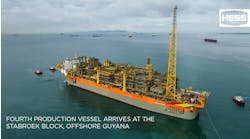Fitness for service enables informed integrity management decisions
Pieter van der Vyver, Oceaneering
As the world continues to demand energy sources, there is mounting pressure on hydrocarbon producers to find new reserves and extract more from existing assets. In recent years, the industry has made noticeable advancements in recovery techniques, using efficient technology to extend the life of mature fields.
As these facilities are extended beyond their original design life and the burden for integrity verification and assurance steadily increases, it is essential to demonstrate continued safety and integrity of ageing assets.
Any infrastructure which has been in service for an extended period, whether a pressure vessel, pipeline or machine component, has the potential to degrade until it no longer meets the original design requirements. Therefore, the first step in reviewing redevelopment programs on ageing fields is to assess the condition of existing infrastructure and its ability to handle current operational loads. If a condition assessment indicates concerns, then further analysis is required to determine the appropriate remedial action to ensure continued, safe operations.
Fitness for service
Fitness for service (FFS) provides a quantitative engineering evaluation to demonstrate the integrity of a component to continue to operate under a specific set of conditions, potentially in the presence of a defect or degradation mechanism. It translates inspection results into quantifiable operational and safety risks, enabling informed integrity management decisions.
FFS provides a basis for engineers to distinguish between acceptable and unacceptable defects and conditions, with principles based on internationally recognized procedures. Although many industry standards address some form of fitness for service assessment, the American Petroleum Institute (API) compiled the best practices into a single, modular assessment standard (API 579-1), which has become the authoritative publication on FFS.
Clear understanding of risk
The benefits of carrying out FFS assessments are clear: reduced downtime, improved safety, proactive maintenance, all the elements necessary for keeping continued operations as safe, compliant, and efficient as possible. However, the question often arises as to when FFS should and must be applied.
Identifying the point of deviation from design intent is often more complex than expected due to the absence of detailed design information, changes in operating environments, and multiple or complex loading scenarios. Therefore, an FFS assessment should be considered as soon as any reported defects exceed the design code limits. For example, defect size exceeding the limit stipulated in the original fabrication quality control standard, metal loss exceeding the design corrosion allowance, material property degradation to below the material specification limits, or exposed to pressures and temperatures outside of original operating boundaries.
In oil and gas, degradation is often dominated by metal loss as a result of corrosion. Operators tend to use the minimum allowable wall thickness (MAWT) as a guideline to initiate FFS. For piping components there is also a significant reliance on the API 574 guidelines for minimum structural wall thickness; although these do not consider material grade, span length, operating medium or support arrangements.
For example, a 6-in. schedule 40 pipe system has a nominal thickness of 7.11 mm, inclusive of a potential 12.5% thickness under tolerance. If this is specified to have a 1.5 mm corrosion allowance, it results in a minimum design wall thickness of 4.72 mm. The API 574 Default Minimum Structural Thickness for a 6-in. carbon and low-alloy steel pipe is 2.8 mm. If designed for internal pressure of up to 50 bar (725 psi), the MAWT for pressure retention could be 1.21 mm (depending on material grade).
If MAWT is used to initiate FFS assessment, there would be no possibility of a successful outcome for this hypothetical scenario, the remaining wall thickness would not satisfy the API 579 Limiting Thickness criteria. Similarly, if the API 574 structural thickness is used for initiating FFS assessment and the pipe system is operating at temperatures above 149°C (300°F), it could experience local thermal pipes stress levels requiring levels well in excess of the structural thickness. For pressure vessels it is even more complex due to local changes in geometry, localized reinforcement zones, major structural discontinuities, and loading complexities.
Simply considering components based on thickness for pressure retention could leave operators exposed to a substantial risk. Performing at least basic FFS once the design requirements are no longer satisfied can reduce the risk and provide valuable insight into operating boundaries and future degradation, as well as highlight future requirements for advanced FFS and potential repair.
Decoding degradation
The first step of assessing any defect is identification of the damage type. The assessment procedures are damage specific, with the API 579-1 standard providing assessment methods for 12 different types of damage. Understanding the damage is also important for predicting the progression and determining the remaining safe, operating life.
For each damage type there is a subset of assessment methods, each with specific applicability and limitation criteria that needs considering. There are also different levels of assessment, with progressively increased accuracy and reduced conservatism, accompanied by an increase in required accuracy of input information:
• Level 1 - very basic and aimed at quick screening of defects in simple components, normally considering pressure retention only
• Level 2 - intermediate, for more complex components with additional loads, increased accuracy enables a reduction in design safety margins
• Level 3 - advanced assessment of complex components or severe degradation using detailed mathematical modeling to determine structural stability.
Component classification
API 579-1 uses an alpha-numeric classification system based on component complexity and loading conditions to determine the appropriate minimum level of assessment:
• Type A - is the most basic component, with a simple geometry and equation relating thickness to pressure, and simple loading conditions dominated by pressure. Type A components are perfectly suited for Level 1 assessment
• Type B class 1 - have similar basic geometries and thickness equations to Type A components but requires consideration of additional loading conditions due physical size and/or exposure temperature. Type B class 1 components requires level 2 assessment as a minimum
• Type B class 2 - are more complex components with thickness interdependencies requiring procedural design evaluation rather than simple thickness. Type B class 2 components requires Level 2 assessment as a minimum
• Type C - have the most complex geometries and load distribution normally causing significant local structural or stress discontinuity requiring advanced mathematical analysis by means of the Level 3 assessment.
Assessment in action
During a routine inspection localized corrosion under insulation (CUI) was detected above a horizontal stiffener ring in a large vertical vessel. Local metal loss spanned approximately 200 mm upwards from the stiffener ring covering locally the entire circumference of the shell. Accurate thickness measurements were not immediately possible due to surface condition, but estimates suggested only 7 mm remaining of the original 16 mm wall in the worst affected area.
Oceaneering was contacted for advice on how to accurately assess the safety and ongoing operability of the equipment. The production facility had capacity for a short-term, partial shutdown of five days for surface preparation and inspection of the damaged vessel. Beyond this, if a longer repair time was necessary, the facility would require a complete shutdown, resulting in substantial financial loss. Primary concern centered around the immediate safety of personnel and equipment, followed by mitigation of any required downtime. FFS would provide valuable information on whether continued operation was safe and achievable, while a suitable repair strategy was investigated, designed, and implemented.
The vessel dimensions did not satisfy the requirements for Type A component classification, as additional loading conditions had to be considered. The location of the defect, immediately adjacent to a stiffener also did not satisfy Level 2 applicability requirements, indicating finite element stress analysis would be required to evaluate the local stress and strain distribution. Therefore, advanced FFS (Level 3) was the only suitable assessment.
The company quickly provided a preliminary (Level 2) assessment based on the initial information available, while the operator proceeded with short-term shutdown for surface preparation and detailed inspection. Although not suitable to certify the integrity, the indicative assessment provided a preliminary indication of the potential failure risk and the likelihood of a successful Level 3 assessment outcome, thereby enabling the operator to focus immediate efforts on recommissioning or repair. It also initiated geometric modeling for FEA to expedite the assessment process.
The original vessel design included consideration of both internal pressure and vacuum conditions, with normal operation under partial vacuum. The company’s indicative assessment showed that the original design was governed by the vacuum loads, not internal pressure. It anticipated that the vessel would withstand internal pressures well in excess of the maximum design pressure, as well as full vacuum conditions, at the initially reported thickness levels. However, subsequent detailed inspection revealed the metal loss was substantially greater than originally stipulated, with remaining thickness of only 2.5 mm in the worst affected area. This increased the urgency for a Level 3 assessment, and reduced confidence in a successful outcome.
To expedite results, a phased approach to assessment load cases was followed. Firstly, combined vacuum, weight, and thermal loads were assessed to demonstrate safety for continued normal operation. The limit load and buckling assessment indicated overall structural stability and adequate resistance to buckling under full vacuum, with no change in design buckling behavior in the presence of the defect, and no excessive plastic strains. The vessel was deemed fit for continued service for normal operation (partial vacuum) and preparations for recommissioning could commence, with appropriate protections to avoid upset conditions.
Secondly, assessment of internal pressure, weight, and thermal loads during upset conditions were assessed. The assessment indicated potential structural instability and excessive plastic strains at pressures exceeding 70% of design maximum pressure, requiring derating of the vessel for potential upset conditions. Finally, assessment of wind loads indicated that vessel integrity would not be compromised at design wind speeds.
Oceaneering concluded that due to the low minimum remaining thickness and the required derating for internal pressure, the vessel would not be able to sustain any significant further metal loss. It was deemed fit for short-term continued service, provided it was derated to 70% of its original design maximum pressure, that further degradation was inhibited by temporary corrosion protection, and a suitable repair is designed and implemented in a reasonable timeframe.
Proven benefits of applying FFS
Due to the criticality and urgency associated with FFS, regular progress feedback and preliminary results are critical to enable accurate decision making without the need to wait for a final formal report. For the above example, the company provided the customer with indicative results and the ability to make an informed decision within three days, ensuring equipment could be safely recommissioned, in tandem with seeking repair solutions.
In most cases, when FFS is conducted by competent industry advocates, the cost of the assessment is greatly outweighed by the benefits of gaining a more detailed understanding of the damage, potential risk, safe operating boundaries and likelihood of repair. FFS provides valuable insight into the risks associated with component and defect combinations and it supports effective future integrity management.
Including FFS technology and assessment capabilities as part of asset management strategy can create substantial operational efficiencies, reduce the likelihood of unplanned and costly repairs. Ensuring that operators are fully aware of what FFS is and why it exists as part of a maintenance program budget can prevent extended shutdowns, enhance recovery, and keep assets safe for longer. •




